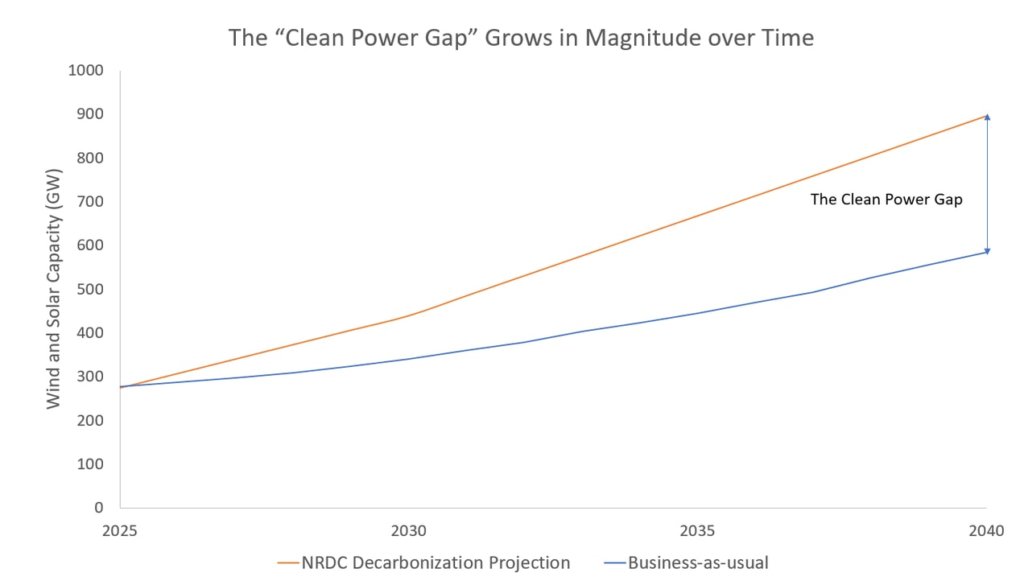The gap between how much wind and solar energy we need to install to curb climate change and how much we are projected to add in a business-as-usual case will get wider over the next few decades. To close this “clean power gap,” we must increase our investments in renewable energy at the scale needed to ensure a safer future for all of us.
Where are the gaps?
Let’s take closer look at the projected clean power gap. If we don’t reach the required levels of energy efficiency, the clean power gap will be even larger than what we’ve shown here:

NRDC’s America’s Clean Energy Frontier report estimated how much wind and solar power we would need to reduce U.S. carbon emissions 80% by 2050 while still supporting a growing economy. We now have compared this “deep decarbonization” trajectory to the most recent business-as-usual (BAU) projections from Bloomberg New Energy Finance and the National Renewable Energy Laboratory.
We found that in 2030, if we were to continue along our BAU trajectory, we would already be almost 100 GW behind. This is enough to power over 35 million homes. Looking out to 2040, the shortfall could grow to 310 GW – which is more than 40% of fossil fuel-powered capacity currently operating in the entire country at the end of 2017.
NRDC’s analysis assumes a ramp-up in energy efficiency initiatives that reduce energy use by 40%. This means that we will need to install even more energy to meet our climate goals. This growing gap is significant, and it provides ample reason for us to think carefully about how to close the gap with a sense of urgency.
How will we close the widening gap?
There are a number of critical steps we must take to close this clean power gap through ambitious energy efficiency and renewable energy initiatives.
First, small distributed energy systems (such as rooftop solar) can increase the resiliency of the grid, boost local generating capacity, and provide households and businesses with the opportunity to personally take part in the booming clean energy economy and gain greater control over their energy supply.
Second, larger community and corporate renewable projects will provide towns and businesses with new opportunities to invest in and power their operations with clean energy. By investing in renewable energy projects, corporations can appeal to employees’ and consumers’ environmental values, meet corporate social responsibility goals, and reduce energy costs in the long run. While small-scale and corporate investment is important, we will also need to increase the amount of large (utility-scale) solar and wind.
This growth and investment in small- and large-scale renewables are imminently feasible. Solar and wind resources have grown eight-fold in the last decade and now provide almost 10% of U.S. electricity. And over the past decade, the cost of wind and solar has dropped by more than 70% and 85%, respectively.
In addition, distributed resources are important: Rooftop solar could provide between 200 and 275 GW of U.S. electricity capacity by 2050, which could help close almost half the gap, but more work is needed on market and policy fronts to ensure that the full potential is realized.
Corporate demand is a driver
Corporate demand for renewable energy continues to grow and is projected to reach 60 GW by 2025. In fact, 116 companies have pledged to go 100% renewable, including Fortune 100 companies such as Procter & Gamble, Google and 3M. Some have already achieved this milestone.
Companies can invest in renewable energy by purchasing renewable energy credits (RECs) that certify that a certain amount of the power they consume is generated from renewable resources. In addition, corporations are increasingly commissioning renewable energy projects. Innovative partnerships between corporations, municipalities and utility companies such as the Green Direct program allow corporations to invest directly in renewable energy projects. This rising increase in demand from consumers for clean energy underscores the importance for utilities to rapidly invest more in large-scale wind and solar.
Utilities must accelerate large-scale renewables investments
While distributed resources and projected corporate investment can provide a considerable amount of capacity, utility companies will need to pick up the pace to stay on track to achieve as many renewable installations as are needed – over 800 GW by 2040.
The good news is that many utilities have already started planning how to meet the increasing demand for renewables from corporate and residential consumers. In addition, this will cut consumers’ utility bills. For example, by 2020, PacificCorp (located in the Western and Midwestern U.S.) plans to install 1.1 GW of new wind resources and will transition many fossil fuel plants to wind. At the same time, existing coal capacity in the Midwest is projected to be reduced by 3.65 GW through the end of 2036. This would result in savings for consumers throughout the Midwest. In the Southeast, Georgia Power plans to procure 1.05 GW of utility-scale resources from renewable energy projects, including a pilot program for commercial customers. The initiative will deliver long-term cost-savings to customers, as outlined in the company’s 2016 Integrated Resources Report.
This is a good start, but as stated in NRDC’s Vision for the Future of the Electric Industry, utilities also need to change their business models in order to install large renewable energy power plants and reduce the cost of integrating renewable energy affordably and reliably into the power mix. NRDC experts are working on policies and advocacy to remove barriers in this process.
Renewable portfolio standards (RPS), which require a certain percentage of a state’s electricity mix to come from renewable resources, have been an effective tool in 29 states in increasing the amount of renewable energy installed; they are responsible for half of installed renewable energy installations since 2000. Though RPS are an important tool, further regulatory reforms are necessary.
Adopting rate designs that encourage energy efficiency, avoid inequitable fixed utility bill charges, and appropriately credit the value of both utility-scale renewable energy and locally generated solar are essential in sending the right signals to customers and energy project developers.
To make sure that wind and solar energy can be delivered to areas that use the most energy, transmission builders need to think strategically. Transmission systems should be sited and constructed in ways that minimize damage to ecosystems and communities. NRDC has long advocated for building “Smart from the Start,” as discussed here and here.
On the demand side, technologies such as electric vehicles, microgrids, heat pumps, battery storage and home storage systems can complement an increase in renewable energy. Green Tech Media Research projects that the U.S. annual market for energy storage will reach 2.6 GW by 2022.
But we need quicker action. Utilities must rise to the challenge and invest in the regulatory, financial and technical systems needed to ensure the scale of decarbonization necessary to limit the increase in global warming to below 2 degrees.
This blog was reposted with permission from the Natural Resources Defense Council (NRDC). Sneha Ayyagari is a Schneider Sustainable Energy Fellow at NRDC.




